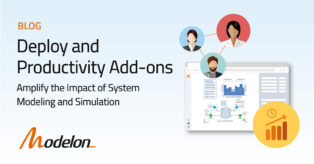クラウドかセルフマネージドか: Modelon Impactのホスティングオプション

産業システムを仮想的に設計、シミュレーション、分析するためのクラウドプラットフォームであるModelon Impactについては、おそらく聞いたことがあるかと思います(そうでない方は、ぜひこちらの概要ビデオを日本語字幕をオンにしてご覧ください)。もしくは、Modelon Impactを評価または購入をご検討されている方もいるかもしれません。
Modelon Impactを使用する前に、重要な質問に答える必要があります。Modelon ImpactクラウドとModelon Impactセルフマネージドの間で、どのホスティングオプションが貴社に適しているのでしょうか?
本ブログでは、どちらを選ぶべきかを決定するための基準を検討していきます。これにより、最大の価値を引き出すことができるようになるでしょう。
Modelon Impactクラウドとは
Modelon Impact クラウドは、インターネットに接続されている場所であればどこでもModelon Impactにアクセスすることができ、セキュリティと安心感を提供します。プラットフォームは、世界中の企業が使用するために、モデロンによって更新、管理、セキュリティで保護され、維持されています。
Modelon Impactセルフマネージドとは
Modelon Impact セルフマネージドは、新しい機能、ライブラリ、セキュリティアップデートがリリースされると、お客様がModelon Impactを管理し、維持し、更新する必要があります。
セルフマネージドに関心のある方には、2つの導入方法があります。一部の企業は、ダウンロードし、ローカルストレージとローカルサーバー上でModelon Impactを実行します。また、Modelon Impactを企業のクラウドインフラストラクチャと統合し、より高い柔軟性をユーザーに提供する企業もあります。
クラウドを選ぶ理由
- 自動アップデートとメンテナンス: モデロンがソフトウェアのアップデート、パッチ、メンテナンスタスクを管理するとき、お客様は社内作業なしでModelon Impactの最新バージョンにアクセスすることができます。Modelon Impactクラウドアップデートは、作業負荷を軽減し、メンテナンス活動に関連するダウンタイムを最小限に抑えます。
- 迅速な展開: お客様が管理する場合、ハードウェアとソフトウェアコンポーネントの調達、インストール、構成、およびテストは、多くの場合、新しいソフトウェアシステムの展開を大幅に遅らせます。Modelon Impact クラウドを使用すると、通常、サブスクリプションにサインアップしてすぐにサービスを使い始めることができるため、物理システムのモデリングとシミュレーションのTime-to-Valueが短縮されます。
- グローバルエキスパートサポート: Modelon Impact クラウドは、プラットフォーム管理、アップデート、エラー処理が一元化されているため、オンサイトのITメンテナンスの必要性を低減します。私たちの専門家は、最大の可用性を確保するためにシステムを監視します。モデロンは、経験豊富なエンジニアによるプラットフォームと1対1のリモートサポートを提供します。私たちのサポートチームはまた、Modelon Impact セルフマネージドで問題を抱えている方々を支援することができます。ただし、私たちの専門家は、私たちだけで問題を解決する力は限られており、お客様との協業を行います。(平野注:原文通りだと突き放した印象を持たれそうで逆効果になりそうだったので、文面を補足しました。)
- 強化されたセキュリティとデータの冗長性: モデロンは、プラットフォームとお客様のデータを保護するためのセキュリティ対策に多額の投資をしています。これには、すべての情報にTLS(Transport Layer Security)とSSL(Secure Sockets Layer)を使用することが含まれます。さらに、認証失敗の監視と悪意のあるユーザーエージェントのブロックは、プラットフォームの安全性を維持するのに役立ちます。モデロンはまた、業界標準の冗長性、バックアップ、およびリカバリの慣行を使用しています。さらに、モデロンは、外部の認定された第三者によって監査されています。
- グローバルな展開: モデロンは、世界最大級のインフラストラクチャプロバイダーと提携しているため、世界中で信頼性の高いシミュレーション性能を提供しています。このグローバルな展開により、お客様は、インターネット接続があればどこでもシミュレーションの力を活用することができます。
- IT負担の軽減: インフラ管理とソフトウェアメンテナンスをモデロンにアウトソーシングすることで、企業はITスタッフを解放し、戦略的イニシアティブやより価値の高い業務に集中することができます。ITの負担を減らすことは、技術革新の増加、モデロンの専門家による簡素化された顧客サービス、変化するビジネス要件への対応におけるより大きな敏捷性につながります。
誰がModelon Impactセルフマネージドを使用すべきでしょうか?
貴社が厳格なソフトウェア管理要件を持っている場合、Modelon Impact セルフマネージドは実用的な選択肢です。
私たちのチームは、業界を越えて作業し、これらのポリシーの必要性を理解しています。Modelon Impactセルフマネージド採用企業は、年に2回のメジャーリリースを受け取りますが、クラウド版採用企業はより頻繁にアップデートを受け取ります。セルフマネージド採用組織は、彼らのニーズを満たすために、システムのスケールを確保する責任があります。
移行時に期待できること
Modelon Impact クラウドに切り替えると、既存のデスクトップ環境(他のModelica標準ツールを含む)からモデルをエクスポートし、私たちの合理化されたインポート機能を使ってModelon Impactにインポートすることができます。GitやSVNのようなバージョン管理システムを使用しているチームは、Modelon Impact内の既存のコードにアクセスするために、そのシステムに接続することができます。
ツールの切り替えは複雑ですが、当社のプロフェッショナルサービスチームが、お客様のエンジニアリングワークフロー、データ、ライブラリをModelon Impactに移行するお手伝いをします。
切り替え方法
既存のお客様は、アカウントマネージャーに連絡して切り替えを開始してください。以下のHelp Centerのリンクより具体的な手順をご参照ください。
Modelon Impact クラウドへのモデルのインポート
ワークスペース共有による移行のスピードアップ
デスクトップからModelon Impact Cloudへのワークスペース変換
Modelon Impactの機能とクラウドベースのシステムモデリングおよびシミュレーションツールの利点に興味がある方は、こちらをクリックして、私たちの専門家にご相談ください。

